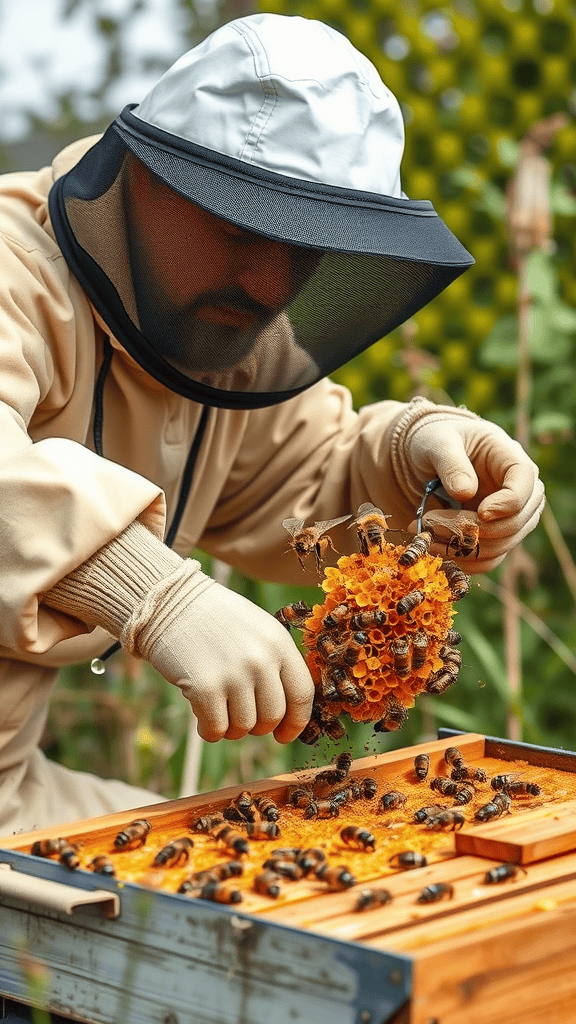Key Steps for Successful Backyard Beekeeping
Starting your own backyard beekeeping adventure can be an exciting and rewarding journey. Here are key steps to help you set up a successful beekeeping practice in your own yard.
Understand Local Regulations
Before you start, it’s essential to check the local laws and regulations about beekeeping. Different areas have specific rules regarding hive placement, number of hives allowed, and other factors. Make sure to comply with these local guidelines to ensure a harmonious relationship with your neighbors and the local community.
Learn About Bees
Understanding the basic biology and behavior of bees is crucial for successful beekeeping. Here are some essential points to consider:
- Types of Bees: Familiarize yourself with the queen bee, worker bees, and drones. Each has a different role within the hive.
- Life Cycle: Learn about the life cycle of bees, including how they reproduce, care for their young, and sustain the colony.
- Foraging Behavior: Understand how bees forage for nectar and pollen and the importance of these activities for honey production.
Choose the Right Location
The location of your hives is one of the most critical factors for successful beekeeping. Keep the following points in mind:
- Sunlight: Hives should receive ample sunlight, especially in the morning, to encourage bees to start foraging early.
- Water Source: Ensure there is a nearby water source, as bees need water to cool their hive and sustain their colony.
- Wind Protection: Place your hives in a sheltered area to protect them from strong winds and harsh weather conditions.
Gather Essential Equipment
Once you’ve decided on a location, gather the necessary equipment for beekeeping:
- Beehive: Choose between various hive types, with the Langstroth hive being the most common for beginners.
- Bee Suit: Invest in a good-quality bee suit to protect yourself from stings.
- Tools: Essential tools include a hive tool, smoker, and bee brush. These will help you manage the hive effectively.
Order Bees
Once you’re equipped, it’s time to order your bees. You can choose between:
- Nuc (Nucleus Colony): This small colony includes a queen, workers, and some brood. Nucs are often easier to manage for beginners.
- Package Bees: These come in a container with a queen and several thousand worker bees, usually without brood.
Order your bees from a reputable supplier to ensure they are healthy and well-treated.
Install Your Bees
When your bees arrive, it’s essential to install them into the hive carefully. Follow the instructions provided by your supplier. Make sure to:
- Keep calm and work slowly to avoid stressing the bees.
- Ensure the queen is released properly to begin establishing her role in the hive.
Regular Hive Management
After establishing your hive, regular maintenance is crucial:
- Inspect Regularly: Check your hive every 7-10 days for signs of disease, pests, or queen issues.
- Maintain Honey Supers: Add honey supers as the colony grows, allowing them more space for honey storage.
- Harvesting Honey: Once the supers are full, plan to harvest honey in late summer while leaving enough for the bees to survive winter.
Join a Beekeeping Community
Connecting with other beekeepers can provide valuable support. Find local clubs or online groups where you can share experiences, ask questions, and learn from others’ successes and mistakes.
By following these steps, you’ll be well-equipped to start your backyard beekeeping journey. It takes dedication, patience, and a willingness to learn, but the rewards of beekeeping are plentiful. You will support local ecology, enjoy fresh honey, and witness the fascinating world of bees first-hand.
Essential Equipment and Supplies for New Beekeepers
Getting started with beekeeping can be an exciting and rewarding journey. If you’re eager to dive into this fascinating hobby, having the right equipment and supplies at your fingertips is essential. This guide will walk you through the must-have tools for new beekeepers to ensure a successful beginning.
Protective Gear
Your safety is a top priority while working with bees. Protective gear will help you stay safe from stings. Most new beekeepers should invest in:
- Bee Suit: A full bee suit offers coverage, and many come with a veil to protect your face.
- Gloves: Wear gloves made specifically for beekeeping. They are thicker than regular gloves to prevent stings.
- Veil: If you opt for a separate veil, ensure it fits comfortably and offers good visibility.
Beehives
Choosing the right type of beehive is crucial for your bees’ health and your ease of management. The most common beehive type for beginners is the Langstroth hive. Here’s what you need:
- Hive Components: You will need the hive body, frames, foundation, and a bottom board.
- Supers: These are additional boxes placed on top of your hive to accommodate honey storage.
- Hive Tools: A hive tool is essential for prying apart frames and scraping propolis.
Bee Feed
When you first start beekeeping, your bees may need extra nourishment. Having bee feed on hand can ensure their health:
- Sugar Syrup: A 1:1 ratio of sugar and water is a common feed. This helps in stimulating the colony, especially in early spring.
- Pollen Patties: These are useful for supplementing protein, especially during times when natural pollen sources are scarce.
Tools for Maintenance
To maintain your hive effectively, certain tools will help with your daily tasks:
- Smoker: This tool helps soothe bees when you’re working in the hive. The smoke calms them, making your job easier.
- Bee Brush: Use a bee brush to gently move bees off the frames without harm.
- Queen Excluder: This prevents the queen from laying eggs in the honey supers, ensuring honey remains free from brood.
Hive Monitoring Devices
Proper monitoring is key to keeping your bees healthy:
- Thermometers: These help check the hive temperature, ensuring it stays optimal for your bees.
- Moisture Meters: Too much moisture can harm your hive, so these devices help keep track of humidity levels.
First Aid Kit
Even the most careful beekeeper can experience stings. Having a basic first aid kit on hand is a wise move:
- Antihistamines: Helpful for allergic reactions to bee stings.
- Ice Packs: These can reduce swelling and discomfort from stings.
- Band-aids and Sterile Gauze: Useful for any minor injuries while working around the hives.
Educational Resources
Equipping yourself with knowledge is just as important as having the right tools:
- Books: Look for beginner-friendly books about beekeeping.
- Online Forums: Joining online communities can offer support and advice from experienced beekeepers.
- Local Beekeeping Clubs: Connecting with local beekeepers can provide practical insights and camaraderie.
By gathering these essentials, you’ll be well-prepared to embark on your beekeeping journey. With the right equipment, your chance of success increases significantly, allowing you to grow as a beekeeper and enjoy the many benefits of maintaining a healthy bee colony.
Conclusion
Starting your backyard beekeeping journey can be an incredibly rewarding experience, both for you and the ecosystem. By following the key steps for successful beekeeping, you set the foundation for a thriving hive. Understanding bee behavior, maintaining hive health, and practicing responsible beekeeping techniques are all essential components that can lead to your success.
Equipping yourself with the right tools is just as vital. Essential equipment and supplies not only ensure your safety but also create a comfortable environment for your bees. From selecting the appropriate hive type to gathering protective gear, having everything organized before your bees arrive will ease the transition into beekeeping.
As you embark on this fascinating adventure, remember that patience and continuous learning are crucial. Beekeeping is not just about harvesting honey; it’s about fostering a relationship with these incredible creatures. Each visit to your hive will bring new challenges and joys, deepening your appreciation for the natural world.
Engaging with local beekeeping communities can offer additional support and knowledge. You can share experiences, ask questions, and even participate in local events or workshops. This camaraderie can help ease your transition into the rewarding world of backyard beekeeping.
Embrace the journey and take the time to immerse yourself in this beautiful hobby. Your bees will thank you by pollinating your garden and, perhaps, even gifting you with delicious honey! Start today and cultivate not only your beekeeping skills but also a lasting connection with nature.
As an Amazon Associate, I earn from qualifying purchases.

